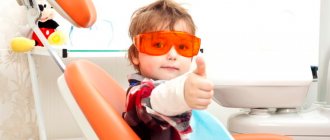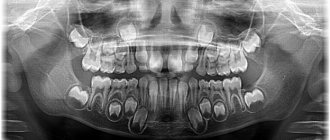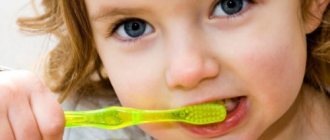Changing children's baby teeth to permanent ones is always an exciting time for parents. This process is quite lengthy and often painful for the child, because it can be accompanied by various inflammations and discomfort. To help parents, for a better understanding of the physiological processes associated with the formation of teeth, dentists offer to look at the pattern of loss of baby teeth in children.
Bookmarking teeth
The formation of baby teeth occurs at approximately 4-6 weeks of fetal development. At the same time, the formation of the fundamental elements occurs much later - during the first months of the child’s life. For this reason, new mothers who are bottle-feeding are strongly recommended to supplement their baby’s diet with calcium. This substance promotes the proper formation of tooth enamel.
At an early age, unprotected baby teeth are extremely susceptible to carious lesions. Parents should monitor this closely, as infection can subsequently cause destruction of permanent teeth. The fact is that the rudiments of permanent teeth are in close proximity to the roots of milk teeth, so as soon as you discover dark spots on your child’s enamel, immediately go to pediatric dentistry.
What reactions of a child’s body are possible during the period of loss of baby teeth and growth of permanent teeth?
Replacing teeth is almost painless. The loss of baby teeth occurs on their own after their root is completely absorbed or removed at home, and if the permanent tooth is already growing, but the permanent one has not yet fallen out, the help of a pediatric dentist is required. When permanent teeth erupt, pain usually does not occur. Very rarely, there may be a slight increase in body temperature, itching of the gums or discomfort in the abdomen. In this case, the child does not need treatment, but it is recommended to visit a dentist.
Baby teeth in children: loss pattern
Many mothers are concerned about the question of when their children’s baby teeth begin to fall out. As a rule, this process starts immediately before primary school, that is, at the age of 6-7 years. In this case, the pattern of loss of baby teeth in children is similar to the sequence of their eruption. Only the fangs differ, which are replaced later, by the age of 13.
The order in which baby teeth fall out is the same for almost all children. First, molars grow - molars, which were absent in the “milk” set. As soon as there is enough space in the child’s jaw, “sixes” begin to appear. Only after this comes the time to change temporary teeth.
First, the lower incisors fall out, and then the upper ones. After this, the premolars appear at about 9-11 years of age. The last in line are the fangs, which usually fall out by the age of 10-12 years. At the same time, there should already be molars in the child’s mouth. After 18 years, third molars or, as we used to call them, wisdom teeth begin to emerge. However, they do not appear in everyone, which, by the way, does not indicate the presence of any pathologies.
Main deviations when changing teeth.
- “Shark mouth” - when the milk teeth have not yet fallen out, but the molars have already grown in the second row.
You need to go to the dentist and have temporary teeth removed, otherwise your bite will suffer.
- Untimely change of teeth - when baby teeth begin to fall out before 5 years of age or after 8 years of age.
The reasons for this deviation may be trauma, caries, nutrition, heredity, infectious diseases, hormonal problems, as well as various diseases (diabetes, leukemia, immunodeficiency, etc.).
- The baby tooth has fallen out, but the molar tooth is not growing.
An x-ray will help identify the cause. For example, if there is no tooth germ in the picture, this is edentulous (the tooth simply has nothing to grow from). Here you will need the help of a prosthetist.
These problems occur in approximately every tenth child. Fortunately, qualified dentists know what to do in this or that case!
What should parents do?
The process of changing teeth in children worries parents, but this is quite natural, and most children do not experience significant pain. However, this does not relieve parents of the need to constantly monitor the condition of their child’s oral cavity. There is no need to remove baby teeth yourself. When the time comes to say goodbye to a tooth, a certain mechanism is activated in the child’s body that dissolves the milk tooth roots. You should seek help from a specialist only if the baby tooth does not want to fall out, but the permanent one is already beginning to appear.
After a tooth falls out, you may experience some bleeding. If desired, have your child rinse his mouth with a solution of soda with a drop of iodine as a preventative measure.
If you have a problem similar to that described in this article, be sure to contact our specialists. Don't diagnose yourself!
Why you should call us now:
- We will answer all your questions in 3 minutes
- Free consultation
- The average work experience of doctors is 12 years
- Convenient location of clinics
Single contact phone number: +7
Make an appointment
Complete replacement of baby teeth with permanent teeth. Deadlines, features.
Features of replacing baby teeth with permanent ones
Often, during the process of replacing teeth, certain features and unusual situations are observed that become a cause for concern for parents.
Let’s briefly look at the most common parental questions: 1. What reactions can a child’s body have when baby teeth fall out and during the period of growth of permanent teeth?
Answer: The process of replacing teeth is virtually painless. Baby teeth fall out on their own after complete resorption of the root or are removed at home, or better yet, by a pediatric dentist, when the permanent tooth is already growing and the baby tooth has not yet fallen out. The eruption of permanent teeth is not accompanied by pain. In very rare cases, there may be a slight increase in temperature, abdominal pain, and itching of the gums. No treatment is required, but consultation with a dentist is recommended.
2. Why do paired teeth not fall out at the same time, but sometimes with a long period of time?
Answer: Firstly, this is what nature intended, and for each child individually. Secondly, it all depends on the time period of resorption of the root of a baby tooth. If baby teeth have been treated or filled, then the root resolves much more slowly, sometimes it does not resolve at all. Filled roots of baby teeth often have to be removed by a dentist because they may not fall out on their own.
3. Why does a lot of time often pass between the loss of a baby tooth and the appearance of a permanent one?
Answer: As a rule, the front teeth grow quickly. But premolars ( baby molars ) and canines are often delayed. After a temporary tooth falls out, it may even take 4-6 months until a permanent tooth erupts in that place. Therefore, you just have to wait and get quality care. But if the period exceeds six months, and you are very worried, come to the appointment. After the examination, the doctor will decide whether it is necessary to stimulate the growth of a permanent tooth.
4. Which teeth should 8-year-old children change?
Answer: By the age of eight, a child should normally have the following permanent teeth - 6th molars, 4 upper incisors and 4 lower incisors. Plus/minus six months is the norm.
5. Why is it necessary to treat caries in children if you then have to pull out the filled roots of baby teeth?
Answer: We have already written (“What is the danger of premature removal of baby teeth”) that an empty space in the dentition contributes to the shifting of existing baby teeth, which means that the rudiments of permanent teeth underneath them shift and they grow incorrectly - in one place they overlap each other each other, and in the other, cracks form. A treated, filled baby tooth preserves space for a permanent tooth. An untreated tooth infects the germ of the permanent tooth with caries, which can lead to deformation or even the absence of the latter.
6. Why does a child aged 7-14 years sometimes experience toothache , but the teeth are all intact?
Answer: Yes, this phenomenon occurs, but it is not the tooth itself that hurts, but the jaw, which is rapidly growing at this age. Permanent teeth are almost twice the size of baby teeth, which means they need much more space. If the new teeth are large, then they can even overlap each other, get out of the dentition, or grow at an angle to each other. As the jaw grows, they settle into place and align. But only a qualified specialist can correctly assess such a situation and the danger of developing defects and anomalies, so consult an orthodontist at the Utkinzub clinic.
7. At what age should a bite be corrected?
Answer: The best option is before the change of baby teeth, from 4-5 years. In this case, permanent teeth will grow, as a rule, evenly, in the place intended by nature. There will be no need for subsequent long-term bite correction. In any case, if there is a malocclusion, the sooner you contact a qualified orthodontist, the faster and better the problem will be eliminated. Read more in the article “Treatment of malocclusions.”
To the question: how to treat caries of baby teeth , you will find a complete answer in the section on caries of children's teeth. It also provides recommendations for the prevention of caries, as well as rotten teeth in children photo . Read about other dental changes in children, diseases, methods of treating them, eliminating deficiencies and pathologies in special articles. Enter the information you are interested in in the “Search on the site” section and you will find articles with answers from our qualified specialists. Or make an appointment with a pediatric dentist at the Utkinzub clinic , especially during the period of eruption of the first teeth and the replacement of temporary teeth with permanent ones in your children.
How many baby teeth do children lose?
The very first teeth appear between the ages of six months and one year. First, the incisors appear, located below and in the center, then the upper ones, and only then the lower lateral and upper lateral ones. This is followed by the first molars, canines and second molars. In pediatric practice, such a concept as a dental formula is used, that is, a standard dental set for children: 2 incisors, 2 molars and a canine. Multiplying the data obtained by four, we get 20 – the number of baby teeth is normal. Accordingly, the same number of baby teeth fall out.
Dental clinic "32 Dent" offers a full range of services in the field of pediatric dentistry. To receive complete and detailed answers to all your questions, call the numbers listed on the website.
At what age should a bite be corrected?
You can start correcting your bite at 4-5 years of age. In this case, the growth of permanent teeth will be even, in the place intended by nature. Therefore, there is no need to carry out subsequent long-term bite correction. In any case, if there is a malocclusion, the problem can be eliminated efficiently and as quickly as possible by contacting a qualified orthodontist as early as possible.
| Teeth | Dairy (temporary) | Permanent | ||
| Jaw | Lower | Upper | Lower | Upper |
| Central incisors | 6-12 months | 8-12 months | 6-7 years | 6-8 years |
| Lateral incisors | 10-16 months | 9-13 months | 7-8 years | 7-8 years |
| Fangs | 17-23 months | 16-22 months | 9-10 years | 11-12 years old |
| First Premolars | — | — | 10-12 years | 10-11 years |
| Second Premolars | — | — | 11-12 years old | 10-12 years |
| First Molars | 14-18 months | 13-19 months | 6-7 years | 6-7 years |
| Second Molars | 23-33 months | 25-33 months | 11-12 years old | 11-13 years old |
When should you start brushing your child's teeth?
Now pediatric dentists are inclined to believe that systematic cleansing of a child’s oral cavity should begin... from the first days of his life. After feeding, you need to take clean gauze or a bandage, wrap it around your finger, moisten it with boiled water and rub it over the newborn’s gums. This is how you can avoid such major troubles as, for example, oral candidiasis (thrush).
Cleaning the first teeth can be done with a cotton swab or fingertip. You should start using toothpaste and brushing at 12-14 months. Almost all children's brushes are now made from soft artificial bristles, but still be careful and check the brush you like: what age it is designed for, and whether it is soft enough. Give preference to products from well-known manufacturers. Toothpaste also differs in composition and taste depending on the age of the children for whom it is intended. The child should be explained that toothpaste should be spat out, even though it is sweet. However, keep in mind: nothing bad will happen if a child swallows a certain amount of paste at first: manufacturers are aware of this tendency of children and make children's pastes safe for the body.
Of course, it is necessary to involve the child in the dental care process as much as possible: show how to use a brush correctly, brush your teeth in the presence of the child, thereby demonstrating how important this procedure is. You can involve your baby in the process of choosing toothpaste and brush, especially since the brush needs to be changed every 3 months. A slightly older child can be asked to choose brushes for the whole family. It is necessary to develop in your child the skill of regular brushing of teeth 2 times a day. More attention should be paid to brushing your teeth at night. And yet, you can let go of the situation and leave the child to his own devices in matters of oral hygiene only when the child turns 10 years old.
Nutrition during the period of changing baby teeth
The enamel of the molars is not fully formed when they erupt. This process lasts several years, so a nutritious diet with properly selected products is of great importance:
- Every day the child should eat food containing large amounts of calcium (milk and dairy products).
- In some cases, if the baby does not want to consume dairy products, it is recommended to take vitamins with a high calcium content.
- Fruits and vegetables, some of them should be consumed in solid form in order to more quickly dissolve milk roots and erupt molars.
- It is recommended to include fish dishes containing phosphorus in your diet twice a week. It is better to give children low-fat varieties, including pike perch, hake and pollock.
- Eliminate chocolate, white pastries and sweets from your diet. Sweet soda is considered the most dangerous for tooth enamel.
During the change of baby teeth, it is necessary to avoid the consumption of sticky or hard foods, including toffees, nuts and candies. Otherwise, you can damage the temporary tooth or cause it to fall out too early, which often causes problems in the growth of permanent teeth. In addition, children should not eat food that contains active dyes, which can negatively affect the color of the enamel of permanent teeth without the possibility of further changing it.
Anatomy of molars
There are three parts to a molar: The crown is the protruding part of the tooth. The root is that part of the tooth that is located under the gum and is held in the jaw bone with the help of connecting bundles. There can be several or one root in a tooth, it all depends on the specific tooth. The neck is the narrowest part of the tooth, located between its root and crown. The top of the tooth is covered by enamel - the hardest and most durable part of the tooth. After the baby’s tooth has erupted, it is covered with cuticle on top of the enamel - a thin transparent layer, which after some time is replaced by a film called pellicle. At the base of the tooth is dentin, which is covered with cement in the root area. Inside the tooth there are root canals and pulp, which is loose tissue filled with blood vessels and nerve endings.
What causes baby teeth to fall out?
Before permanent teeth appear, interesting physiological changes occur, such as the spontaneous resorption of the roots of baby teeth. This is why they begin to wobble and fall out. The germs of permanent teeth are located between the roots of milk teeth, because of this, resorption begins from the place where the root adheres to the germ of a permanent tooth. Resorption starts from the apex of the root and gradually moves towards its base. As soon as this process approaches the neck, the tooth falls out.
Children erupt 20 baby teeth. In the oral cavity, adults have from 28 to 32 teeth. Typically, all baby teeth fall out. In a child by the age of 14, they should be completely replaced by permanent ones.
In what order do teeth change?
As soon as baby teeth fall out, permanent teeth erupt at the same time. There is a close relationship between these two processes. They appear in the same order as they fall out: first, the incisors change, then the first and second premolars, and then the turn comes to the canines.
- The eruption of the first molars (sixth teeth) occurs long before the process of changing teeth; they are immediately permanent.
- Second molars begin to grow in the spaces created by jaw growth.
- In many people, “wisdom teeth” or third molars may not grow at all, or their eruption is very problematic.
How to tell the difference?
It is possible to determine which “generation” a tooth belongs to by its:
- Size and shape. Molars are larger, because they are designed for the jaw of an adult. Their edges and boundaries are clear and lumpy. Dairy ones have rounded, smooth edges.
- Blossom. Children's units are white with a bluish tint, adults are yellowish-gray. This is due to the fact that the latter has a higher percentage of mineralizing components. Over the years, they also turn white, but at first they don’t look very presentable.
- Position in the oral cavity. The molars face towards the lips and cheeks. They appear to be slightly tilted. Dairy plants grow evenly and straight.
If we talk about the differences in more detail :
- Six and seven are always radical. You need to count from the middle line of the row (located between the central incisors) towards the ear. In the milk row there are only fives, since there are ten teeth at the bottom and at the top.
- If you have questions regarding the fours and fives, then maximum attention should be paid to their form. Primary teeth have wide crowns and chewing cusps (usually four). If a change has already occurred, then there will be fewer tubercles and the crown will be narrow.
- Temporary fangs are smaller than permanent ones. By the time they fall out, their sharp tips become dull. Instead, units with clearly pointed apexes grow.
- When assessing the nature of the incisors, you need to look at the size. In dairy ones, the width is about 4 mm, the height is 5-6. Permanent ones are usually larger. During the period of change of bite, children's incisors have smooth, even edges, while adults' incisors are lumpy.











